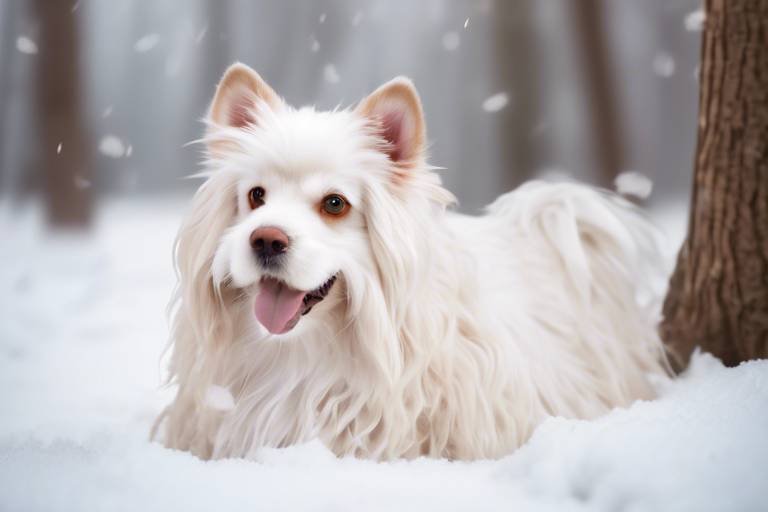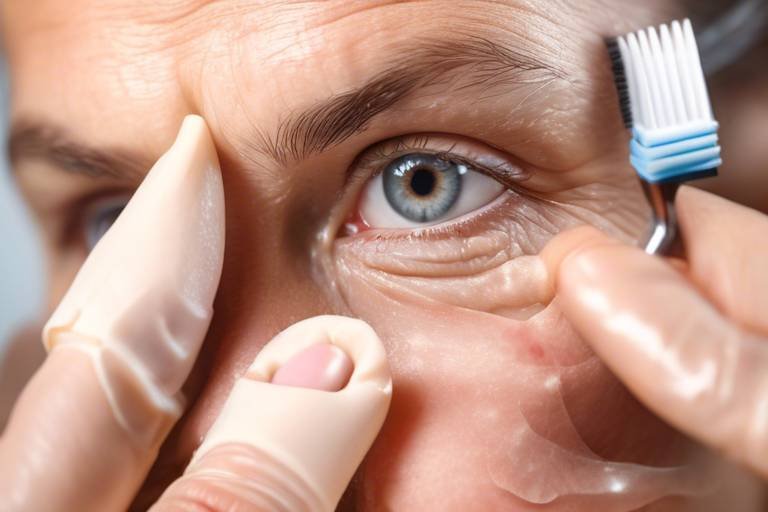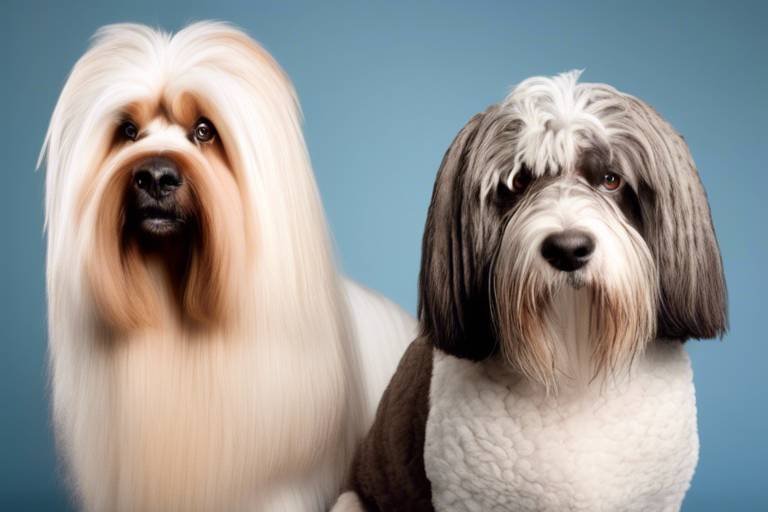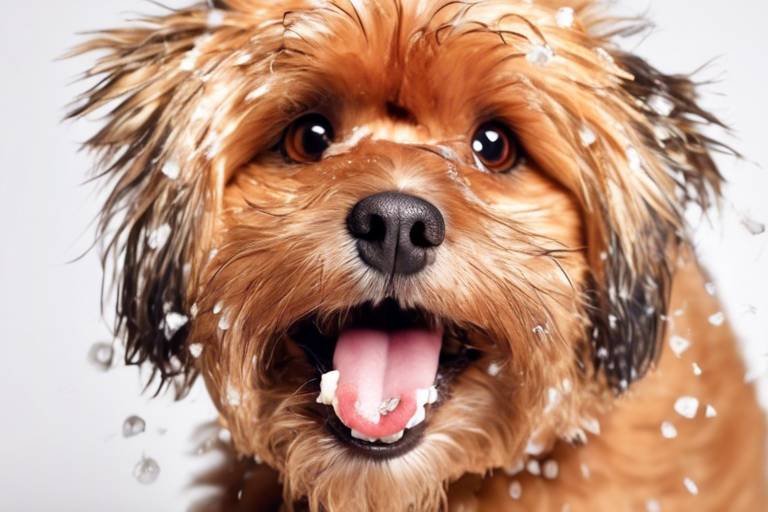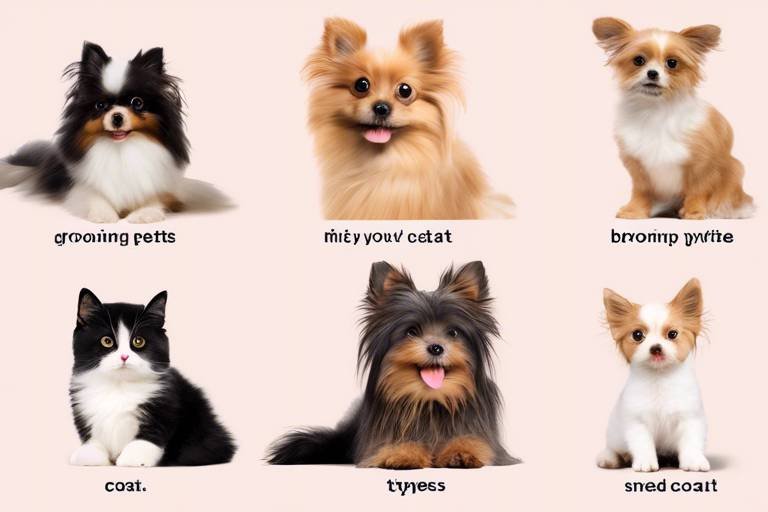How to Maintain Your Pet’s Coat in Different Seasons
This article provides insights into the best practices for maintaining your pet's coat throughout the year, focusing on seasonal changes and grooming techniques to ensure a healthy and vibrant fur.
Pets experience natural coat changes with the seasons, much like how we change our wardrobes. As the weather shifts, so does your furry friend's fur. In winter, you might notice a thicker, fluffier coat that acts as a warm blanket against the chill. Conversely, during the hot summer months, many pets shed their winter coats to stay cool. It's essential to understand these changes so you can adjust your grooming routine accordingly. For example, during spring, you might find yourself battling a shedding storm as your pet prepares for warmer weather. This shedding can be overwhelming, but with the right tools and techniques, you can manage it effectively.
In winter, pets need extra care to keep their coats healthy and vibrant. The cold can be harsh, and it's up to us as pet owners to ensure our furry companions are well-groomed and protected. Regular grooming not only helps maintain a healthy coat but also allows you to check for any skin issues or parasites that might be hiding beneath the fur. Make sure to schedule grooming sessions more frequently during this season, as it can help distribute natural oils throughout their coat, keeping it shiny and healthy.
Selecting the right grooming tools is essential for winter coat care. Not all brushes are created equal, and using the wrong one can lead to discomfort for your pet. For example, if your dog has a thick double coat, a slicker brush is perfect for removing tangles and loose fur. On the other hand, a fine-toothed comb works better for pets with shorter hair. Here’s a quick table to help you choose the right tools based on your pet’s coat type:
| Coat Type | Recommended Grooming Tool |
|---|---|
| Short Hair | Rubber Brush or Bristle Brush |
| Medium Hair | Slicker Brush |
| Long Hair | Wide-Toothed Comb and Slicker Brush |
| Double Coat | Undercoat Rake and Slicker Brush |
Bathing your pet in winter requires special considerations. While it may be tempting to give your furry friend a bath to keep them clean, be mindful of the temperature. Use lukewarm water to avoid shocking their system. Additionally, limit the frequency of baths during winter, as too much washing can strip the natural oils from their skin, leading to dryness and irritation. After bathing, make sure to dry your pet thoroughly, especially if they have long fur, to prevent them from getting cold.
Using protective clothing can help maintain your pet's coat in winter. Think of it as a cozy sweater for your furry friend! Dog sweaters and booties can make a world of difference in keeping your pet warm and their coat healthy. These items not only provide insulation but also protect against salt and chemicals used on sidewalks that can irritate their skin. When choosing clothing, ensure it fits well and allows for easy movement. Your pet will thank you for it!
Spring brings shedding, making it crucial to adjust your grooming routine. As the temperatures rise, your pet will start to lose their winter coat, and this is the perfect time to ramp up your grooming efforts. Regular brushing will help manage the shedding and keep your home fur-free. Consider using a de-shedding tool to make the process easier and more effective. Don’t forget to check for any signs of allergies or skin issues that may arise as the weather changes.
Summer heat can impact your pet's coat health significantly. It's essential to keep your pet cool and comfortable during the hottest months. Regular grooming helps remove loose fur and prevents matting, which can trap heat. Additionally, ensure your pet has access to plenty of water to stay hydrated. A well-hydrated pet is more likely to have a shiny coat, so consider incorporating wet food or adding water to their dry kibble to keep them refreshed.
A balanced diet and proper hydration are vital for a shiny coat. Just like how we need nutrients to look our best, pets require a well-rounded diet rich in omega fatty acids, vitamins, and minerals. Foods containing fish oil or flaxseed can help promote a healthy, shiny coat. Always consult with your vet to ensure you're providing the best diet tailored to your pet's specific needs.
As temperatures drop in fall, grooming becomes essential for coat preparation. This is the time to start transitioning your pet back to their winter coat. Regular brushing will help remove any loose fur and prepare their coat for the upcoming cold months. Pay attention to their paws as well, as fallen leaves and debris can get stuck in their fur. A good grooming session can make all the difference in keeping your pet comfortable and cozy as the weather changes.
- How often should I groom my pet? It depends on your pet’s coat type, but generally, once a week is a good rule of thumb.
- Can I bathe my pet too often? Yes, too frequent bathing can strip the natural oils from their skin, leading to dryness.
- What should I do if my pet has a skin issue? Consult your veterinarian for advice and appropriate treatment.

Understanding Seasonal Coat Changes
Just like us, pets go through changes with the seasons, and their coats are no exception. As the weather shifts, you might notice your furry friend shedding more or their coat becoming thicker. This is a natural process that helps them adapt to the varying temperatures. For instance, in the winter, many pets develop a thicker undercoat to keep warm, while in the summer, they shed this extra fur to stay cool. Understanding these seasonal coat changes is crucial for pet owners who want to ensure their pets remain comfortable and healthy throughout the year.
During spring, the shedding phase often kicks into high gear. This is when your pet might leave a trail of fur wherever they go! The change in temperature and increased daylight hours signal their body to shed the winter coat. It’s important to ramp up your grooming routine during this time to help manage the shedding and keep your home fur-free. On the other hand, as fall approaches, pets will begin to grow their winter coats back, so you might notice them getting fluffier. This transition can sometimes lead to confusion for pet owners, but being aware of these patterns can help you stay ahead.
So, what can you do to support your pet through these seasonal changes? Regular grooming is key! Not only does it help to remove loose fur, but it also stimulates the skin and promotes healthy hair growth. Different breeds have different grooming needs, so it’s essential to tailor your approach based on your pet’s specific coat type. For example, long-haired breeds may require more frequent brushing to prevent mats and tangles, while short-haired breeds might need less maintenance but still benefit from regular brushing to remove dead hair and distribute natural oils.
Additionally, keep an eye on the weather and adjust your grooming routine accordingly. If you live in an area with extreme seasonal changes, consider investing in grooming tools suitable for each season. A good quality de-shedding tool can be a game changer in spring and summer, while a slicker brush is perfect for those thick winter coats. Remember, a well-groomed pet is not only more comfortable but also healthier!
To summarize, understanding how seasonal changes affect your pet's coat is vital. By being proactive and adjusting your grooming routine, you can help your furry friend navigate these transitions smoothly. The next sections will delve deeper into specific grooming techniques and tips for each season, so stay tuned!

Winter Coat Care
As the temperature drops and the snow begins to fall, your furry friend needs a little extra love and attention to keep their coat healthy and vibrant. Winter coat care is not just about keeping your pet warm; it's also about ensuring their fur remains in top condition despite the harsh elements. During this chilly season, pets can face a range of challenges, from dry skin to matting, so it’s essential to adapt your grooming routine accordingly.
First and foremost, regular grooming is key. It helps to remove dead hair and prevent matting, which can be uncomfortable for your pet and lead to skin issues. Depending on your pet's coat type, you might need to adjust your grooming frequency. For instance, long-haired breeds may require more frequent brushing to prevent tangles, while short-haired pets might need a good brush once a week. Remember, a well-groomed coat not only looks good but also keeps your pet warm by trapping heat close to their skin.
When it comes to choosing grooming products, it’s vital to select those that cater to your pet’s specific coat type. For example, slicker brushes work wonders for long-haired breeds, while rubber brushes are excellent for short-haired pets. A good grooming session can also be a bonding experience, so make it enjoyable! Use treats and praise to keep your pet relaxed during the process.
Using the right tools can make all the difference in winter coat care. Here’s a quick guide to help you select the best grooming tools for your pet:
| Coat Type | Recommended Tools |
|---|---|
| Long Hair | Slicker Brush, Wide-Toothed Comb |
| Short Hair | Rubber Brush, Bristle Brush |
| Curly Hair | Pin Brush, Rake Comb |
In addition to grooming, bathing your pet in winter requires special considerations. While it’s important to keep your pet clean, you should be cautious about how often you bathe them. Frequent baths can strip natural oils from their skin, leading to dryness and irritation. Aim for a bath every 4-6 weeks, and use a moisturizing shampoo designed for pets. After bathing, ensure your pet is thoroughly dried before they venture outside. A damp coat in cold weather can lead to chills or even hypothermia!
Here are some tips to keep in mind when bathing your pet during the winter months:
- Use lukewarm water to avoid shocking their system.
- Make sure to dry your pet completely with a towel or a pet-safe blow dryer.
- Consider using a leave-in conditioner to help maintain moisture in their coat.
Don’t underestimate the power of protective clothing during winter! Just like we bundle up in cozy sweaters, our pets can benefit from a little extra warmth. Dog sweaters and booties can protect your pet from the elements and help maintain their coat. Sweaters not only provide warmth but can also prevent snow and ice from getting tangled in their fur. Booties protect their paws from harsh chemicals used on sidewalks and from the cold ground. Plus, who doesn’t love a stylish pup?
In conclusion, keeping your pet’s coat healthy during winter is a combination of regular grooming, the right products, and protective clothing. By taking these steps, you can ensure that your furry friend stays comfortable, warm, and looking fabulous all season long!
Q: How often should I groom my pet in winter?
A: It depends on your pet's coat type. Long-haired pets may need grooming several times a week, while short-haired pets may only need it once a week.
Q: Can I bathe my pet in winter?
A: Yes, but limit baths to every 4-6 weeks and ensure they are thoroughly dried afterward to prevent chills.
Q: Is protective clothing necessary for all pets?
A: Not all pets require clothing, but small or short-haired breeds may benefit from sweaters and booties in cold weather.
Choosing the Right Grooming Tools
When it comes to maintaining your pet's coat during winter, selecting the right grooming tools is absolutely essential. Just like you wouldn’t use a butter knife to slice bread, using the wrong brush can lead to frustration and an unhappy pet. So, what should you be looking for? First off, consider your pet’s coat type. Is it short, long, curly, or straight? Each type requires specific tools to keep it healthy and manageable.
For pets with long hair, a slicker brush is a must-have. This tool effectively removes tangles and mats while distributing natural oils, giving their coat a beautiful shine. On the other hand, if your furry friend has a short coat, a bristle brush or a rubber grooming mitt is perfect for removing loose hair and dirt. These tools not only keep their coat clean but also feel great against their skin, turning grooming time into a bonding experience.
Now, let’s talk about combs. A wide-toothed comb is fantastic for detangling, especially in areas prone to mats, such as behind the ears or under the legs. For pets with thicker or curly coats, a metal comb can work wonders. It’s all about finding the right fit for your pet’s unique needs. If you’re unsure what to get, consult your veterinarian or a professional groomer; they can provide tailored advice based on your pet's specific coat characteristics.
Don’t forget about de-shedding tools! These are particularly useful during shedding seasons, helping to reduce the amount of fur that ends up on your furniture and clothes. Tools like the Furminator can be a game changer, allowing you to remove loose undercoat fur without damaging the top coat. When used correctly, it can significantly cut down on the amount of hair you find around your home.
Finally, consider investing in some high-quality grooming scissors for those tricky spots that need a little extra attention. Whether it’s trimming around the paws or tidying up the tail, having a good pair of scissors can make a world of difference. Remember, grooming is not just about looks; it’s also about maintaining your pet’s health. Regular grooming helps you spot any skin issues early on, ensuring your furry friend stays happy and healthy.
In summary, choosing the right grooming tools is like assembling your pet's personal care kit. The right tools will not only make grooming more effective but also more enjoyable for both you and your pet. So, take the time to research and invest in quality grooming equipment that suits your pet's needs.
Bathing Tips for Winter
Bathing your pet in winter can feel like a daunting task, especially when the temperatures drop and the air turns crisp. However, maintaining your furry friend's hygiene during the colder months is essential for their overall health and comfort. To ensure your pet remains clean without compromising their skin or coat, consider these winter bathing tips.
First and foremost, it's important to choose the right time for a bath. Opt for a day when the weather is a bit milder, as this will help your pet stay comfortable before and after their bath. If possible, try to bathe them indoors where it's warm, as this will reduce the risk of them getting chilled. A cozy bathroom with a space heater can work wonders!
When it comes to water temperature, lukewarm is the way to go. Hot water can strip natural oils from your pet's skin, leading to dryness and irritation, while cold water can give them a nasty shock. Always test the water with your wrist to ensure it's just right. Additionally, use a gentle, moisturizing pet shampoo that is specifically formulated for winter use. These products often contain ingredients that help keep your pet's skin hydrated during the dry winter months.
After bathing, drying your pet properly is crucial. Towels are your best friends here! Use plenty of absorbent towels to gently pat your pet dry. If your pet is comfortable with it, a blow dryer set on a low, cool setting can help speed up the drying process. Just be sure to keep the dryer at a safe distance to avoid overheating their sensitive skin.
To further protect your pet's coat, consider applying a leave-in conditioner or coat spray designed for winter use. These products can help lock in moisture and provide an extra layer of protection against the harsh winter elements. Don't forget to brush your pet's coat before and after bathing; this will help remove any dead hair and prevent matting, ensuring their coat stays healthy and vibrant.
Lastly, monitor your pet's skin after bathing. If you notice any signs of dryness or irritation, it may be time to adjust your bathing routine or consult your veterinarian for advice on suitable products. Remember, your pet's comfort and well-being should always come first!
- How often should I bathe my pet in winter? It's generally recommended to bathe your pet every 4-6 weeks in winter, but this can vary based on their activity level and coat type.
- Can I use human shampoo on my pet? No, human shampoos can be too harsh for pets. Always use a shampoo specifically formulated for animals.
- What should I do if my pet hates baths? Gradually introduce them to the bathing process, using treats and positive reinforcement to create a more enjoyable experience.
Protective Clothing for Pets
When the temperatures drop and winter sets in, your furry friend may need a little extra help to stay warm and comfortable. Just like we bundle up in cozy sweaters and scarves, can make a world of difference. But why is it so important? Well, pets, especially those with shorter coats or less body fat, can be particularly susceptible to the cold, leading to discomfort or even health issues. So, investing in the right winter gear for your pet is not merely a fashion statement; it's a necessity!
First off, let’s talk about dog sweaters. These snug garments not only keep your pet warm but can also prevent matting and damage to their fur. A well-fitted sweater can act as a protective barrier against the biting winds and snow. When choosing a sweater, look for materials that are both warm and breathable to ensure your pet doesn’t overheat indoors. You can find a variety of styles, from classic pullovers to trendy cardigans, making it easy to find something that fits your pet's personality.
Now, don’t forget about booties! Those little paws are sensitive, and exposure to ice, salt, and cold surfaces can cause discomfort or even injury. Booties provide essential protection, allowing your pet to walk comfortably on slippery sidewalks or during long winter walks. When selecting booties, ensure they fit snugly but not too tight, and check that they have a good grip to prevent slips.
In addition to sweaters and booties, consider investing in a waterproof coat for those wet, slushy days. These coats can help keep your pet dry and warm, preventing them from getting chilled after a walk in the rain or snow. Look for options with reflective materials for added safety during those darker winter evenings.
Lastly, it’s essential to remember that not all pets require the same level of protection. For instance, a large breed with a thick coat may not need as much clothing as a small breed with a thinner coat. Always observe your pet’s behavior in cold weather; if they seem uncomfortable or reluctant to go outside, it might be time to layer them up!
In conclusion, protective clothing for pets can significantly enhance their comfort and health during the winter months. By choosing the right gear, you can ensure that your furry companion stays warm, dry, and happy, making winter walks a joy rather than a chore. So, grab that cute sweater and those stylish booties, and let your pet strut their stuff while staying cozy!
- Do all pets need protective clothing in winter? Not all pets require clothing; it depends on their breed, coat type, and individual tolerance to cold. Short-haired or smaller breeds often benefit from extra layers.
- How do I measure my pet for clothing? Use a soft measuring tape to measure the length of your pet's back from the base of the neck to the base of the tail, and their girth around the widest part of the chest.
- Can my pet wear human clothing? While some human clothing can fit pets, it’s best to use clothing specifically designed for pets to ensure comfort and safety.
- How can I tell if my pet is too cold? Signs include shivering, reluctance to walk, whining, or seeking shelter. If you notice these behaviors, it’s time to warm them up!
Spring Grooming Essentials
As the chill of winter melts away and the vibrant blooms of spring emerge, it's time to shift our focus to for our beloved pets. Spring is a season of renewal, but it also brings a unique set of challenges, particularly when it comes to managing shedding. You might notice that your furry friend is losing more hair than usual, and that’s completely normal! Understanding how to adapt your grooming routine is key to keeping your pet comfortable and looking their best.
During spring, many pets undergo a significant coat change as they shed their winter fur. This is the perfect time to invest in some quality grooming tools. A good brush can make all the difference in managing that shedding. Look for tools that are specifically designed for your pet’s coat type, whether it’s long, short, or curly. For instance, a slicker brush works wonders for long-haired breeds, while a bristle brush is great for short-haired pets. Regular brushing not only helps to reduce the amount of fur scattered around your home but also promotes healthy skin by distributing natural oils throughout their coat.
In addition to brushing, consider scheduling regular baths during this season. A bath can help to remove loose fur and dirt, leaving your pet feeling fresh and clean. However, be cautious not to over-bathe, as this can strip the coat of essential oils. Aim for a balance—once a month might be ideal for most pets. When you do bathe your furry friend, use a gentle, pet-specific shampoo to avoid skin irritation. After the bath, a thorough towel dry is essential, especially if the weather is still a bit chilly.
Another important aspect of spring grooming is ear and nail care. With the increase in outdoor activities, your pet's ears may accumulate dirt and moisture, making them susceptible to infections. Regularly check and clean their ears with a vet-recommended solution. Likewise, spring often means more walks and playtime on various surfaces, which can wear down your pet’s nails. Keep an eye on nail length and trim them as needed to prevent discomfort. If you're unsure about how to trim nails safely, consult your veterinarian or a professional groomer for guidance.
To further enhance your pet's grooming routine, consider the following essential grooming tips:
- Hydration: Ensure your pet has access to fresh water at all times. Hydration is crucial for a healthy coat.
- Diet: A balanced diet rich in omega fatty acids can improve coat health. Look for high-quality pet food that includes these essential nutrients.
- Regular Vet Visits: Schedule a check-up to discuss your pet’s grooming needs and any specific concerns you may have.
In conclusion, spring grooming is not just about aesthetics; it’s about ensuring your pet feels comfortable and healthy as they transition into warmer months. By staying proactive with brushing, bathing, and overall care, you can make this shedding season a breeze for both you and your furry companion. Remember, a well-groomed pet is a happy pet!
Q: How often should I brush my pet during spring?
A: It’s best to brush your pet several times a week during spring, especially if they are shedding. Regular brushing helps to manage loose fur and keeps their coat healthy.
Q: Can I bathe my pet too often?
A: Yes, over-bathing can strip your pet's coat of essential oils. Aim for once a month unless they get particularly dirty or smelly.
Q: What if my pet has sensitive skin?
A: If your pet has sensitive skin, consult your veterinarian for recommendations on hypoallergenic grooming products and bathing frequency.
Q: How can I tell if my pet’s coat is healthy?
A: A healthy coat should be shiny, free of mats, and your pet should not be excessively scratching. If you notice any changes, consult your vet.

Summer Coat Maintenance
As the sun blazes down and temperatures soar, it’s essential to give your pet's coat the attention it deserves. Summer can be a challenging time for our furry friends, especially when it comes to maintaining a healthy and vibrant coat. Just like us, pets can feel the heat, and their fur can become a barrier to comfort if not properly cared for. So, how do we tackle this? Well, let’s dive into some effective strategies to ensure your pet stays cool, comfortable, and looking fabulous all summer long!
First and foremost, regular grooming is your best friend during the summer months. Not only does it help to remove excess fur and reduce shedding, but it also promotes better airflow to your pet's skin, which is crucial in hot weather. A good grooming session can be a bonding experience, too! Imagine spending quality time with your pet while keeping them cool and comfortable. When grooming, be sure to use the right tools for your pet's coat type. For example, if you have a long-haired breed, a slicker brush can work wonders, while short-haired breeds may benefit from a rubber curry brush to stimulate the skin and remove loose hair.
Hydration is another critical factor in maintaining a healthy coat during the summer. Just like we need to drink more water when it’s hot outside, pets require extra hydration as well. Make sure your pet has access to fresh, clean water at all times. You might even consider adding a pet-friendly electrolyte solution to their water to help replenish lost minerals due to heat. A well-hydrated pet not only feels better but also has a shinier, healthier coat. In fact, water plays a vital role in the overall health of your pet's skin and fur.
Additionally, nutrition plays a significant role in coat health during the summer. Consider feeding your pet a high-quality diet rich in omega fatty acids, which can enhance skin health and promote a shiny coat. Foods like salmon oil or flaxseed oil can be excellent supplements to add to their meals. However, always consult with your veterinarian before making any changes to your pet's diet. After all, they know your pet’s specific needs best!
Lastly, don't forget about the importance of shade and cool resting spots for your pet. If your furry friend loves to spend time outdoors, ensure they have access to shaded areas and plenty of fresh air. Creating a cool space inside your home with fans or air conditioning can also help your pet beat the heat. Remember, a happy pet is a healthy pet, and keeping them cool during the summer months is essential for their overall well-being.
In summary, summer coat maintenance is all about regular grooming, proper hydration, a balanced diet, and providing a comfortable environment for your pet. By taking these steps, you’ll not only keep your pet looking their best but also help them feel great throughout the hottest months of the year!
- How often should I groom my pet in summer? – It's recommended to groom your pet at least once a week during the summer to manage shedding and keep their coat healthy.
- Can I give my pet a summer haircut? – Yes, many pet owners opt for a summer haircut to help their pets stay cool. Just make sure to consult a professional groomer to ensure it's done safely.
- Is it okay to bathe my pet more often in the summer? – While you can bathe your pet more often, be cautious not to overdo it as it can strip their coat of natural oils. Aim for once every few weeks unless they get particularly dirty.
Hydration and Diet for Healthy Coats
When it comes to maintaining a healthy and vibrant coat for your pet, hydration and diet are two critical components that cannot be overlooked. Just like humans, pets need a well-balanced diet filled with essential nutrients to keep their fur looking its best. Imagine your pet's coat as a beautiful garden; without the right amount of water and nutrients, it can quickly become dull and lifeless. So, how do we ensure our furry friends get what they need?
First off, let's talk about hydration. Water is the most important nutrient your pet can consume. It aids in digestion, nutrient absorption, and even helps regulate body temperature. During the hot summer months, your pet may require more water than usual, especially if they're active. A good rule of thumb is to ensure your pet has access to fresh, clean water at all times. If you're unsure whether your pet is drinking enough, look for signs of dehydration, such as dry gums or lethargy.
Now, onto diet! A nutrient-rich diet can significantly impact the health of your pet's coat. Look for high-quality pet foods that list real meat as the first ingredient. Ingredients like omega-3 and omega-6 fatty acids are fantastic for skin and coat health. These nutrients help to keep your pet's coat shiny and reduce shedding. Additionally, incorporating fresh fruits and vegetables can provide essential vitamins and minerals that contribute to overall health.
Consider a few key dietary elements:
- Protein: Essential for hair growth and repair. Look for foods with chicken, beef, or fish as primary ingredients.
- Fatty Acids: Omega-3 and omega-6 fatty acids can help maintain a healthy coat. You can also consider fish oil supplements.
- Vitamins and Minerals: Vitamins A, E, and zinc play critical roles in skin health and coat condition.
To give you a clearer picture, here's a simple comparison table of some common ingredients and their benefits for your pet's coat:
| Ingredient | Benefit |
|---|---|
| Salmon | Rich in omega-3 fatty acids, promotes shiny coat and healthy skin. |
| Chicken | High in protein, essential for hair growth. |
| Sweet Potatoes | Packed with vitamins and antioxidants, supports overall health. |
| Spinach | Provides vitamins A, C, and K, which are great for skin health. |
In summary, ensuring your pet is well-hydrated and fed a balanced diet rich in essential nutrients is vital for maintaining a healthy coat. Remember, a shiny coat is often a reflection of your pet's overall well-being. So, keep that water bowl full and choose high-quality food options to help your furry friend shine all year round!
Q: How much water should my pet drink daily?
A: A general guideline is about 1 ounce of water per pound of body weight. However, this can vary based on activity level and weather conditions.
Q: Can I give my pet human food for better coat health?
A: Yes, but be cautious. Foods like carrots, apples, and cooked fish can be beneficial. Always consult your vet before introducing new foods.
Q: How often should I groom my pet to maintain coat health?
A: Regular grooming is essential, typically at least once a week, but this can vary based on the breed and coat type.

Fall Coat Preparation
As the leaves turn and the air becomes crisp, it's time to prepare your pet's coat for the fall season. Just like us, our furry friends need to transition their grooming routine to keep their coats healthy and vibrant. During this time of year, your pet's coat undergoes significant changes, and understanding these shifts is essential for effective care. You might be wondering, "What should I do differently?" or "How can I ensure my pet is comfortable as the temperature drops?" Well, fear not! Let's dive into some practical tips for fall coat preparation.
First and foremost, it's important to recognize that fall is a time of shedding for many pets. As the days get shorter and temperatures cool down, your pet may start to lose their lighter summer coat in preparation for a thicker winter coat. This means more grooming sessions are necessary to manage the shedding and keep your home fur-free. Regular brushing not only helps remove loose hair but also distributes natural oils, promoting a shiny and healthy coat. Consider setting aside time each week for a thorough grooming session to keep your pet looking their best.
When choosing grooming tools for the fall, opt for brushes that are suited to your pet's specific coat type. For instance, a slicker brush works wonders for long-haired breeds, while a bristle brush is ideal for short-haired pets. If you're unsure which tools to use, consult your veterinarian or a professional groomer for recommendations. Remember, the right tools can make a world of difference in keeping your pet's coat healthy and manageable.
In addition to grooming, pay attention to your pet's skin during the fall. The change in weather can lead to dryness and irritation. To combat this, consider incorporating a moisturizing shampoo into your pet's bathing routine. Look for products that contain natural ingredients like oatmeal or aloe vera, which can soothe and hydrate the skin. It's also wise to limit baths to once a month during this season, as over-bathing can strip away essential oils and lead to further dryness.
Don't forget about nutrition! A balanced diet rich in omega fatty acids can significantly improve your pet's coat health. Foods that contain fish oil, flaxseed, or chicken fat are excellent choices. If you're unsure whether your pet's diet is meeting their nutritional needs, consult your veterinarian for advice on supplements or dietary adjustments.
Finally, as temperatures begin to drop, consider investing in protective clothing for your pet. Sweaters and jackets can not only keep them warm but also protect their coat from the elements. Look for breathable materials that won't irritate their skin. You might be surprised at how much your pet enjoys wearing a cozy sweater during those chilly fall walks!
- How often should I groom my pet in the fall? Regular grooming sessions, ideally once a week, are recommended to manage shedding and maintain coat health.
- Can I use human shampoo on my pet? No, it's best to use pet-specific shampoos as human products can be too harsh for their skin.
- What signs should I look for that indicate my pet's coat is unhealthy? Look for excessive shedding, dry or flaky skin, and a dull coat. If you notice these signs, consult your veterinarian.
Frequently Asked Questions
- How often should I groom my pet's coat in different seasons?
Grooming frequency can vary by season. In winter, you might groom less often since pets may have thicker coats, but regular brushing is still important to prevent matting. In spring, as shedding increases, you should groom more frequently to manage loose fur. During summer, regular grooming helps remove dirt and keeps your pet cool, while in fall, prepare your pet for the winter coat by grooming to remove dead hair.
- What are the best grooming tools for winter coat care?
For winter coat care, a slicker brush and a wide-toothed comb are excellent choices. Slicker brushes help remove tangles and mats, while wide-toothed combs are perfect for detangling without damaging the coat. Always choose tools that suit your pet's specific coat type for the best results.
- Can I bathe my pet during winter?
Yes, you can bathe your pet in winter, but it requires some special considerations. Use lukewarm water, and make sure to dry your pet thoroughly afterward. Consider using a moisturizing shampoo to prevent dry skin, and try to limit bathing to avoid stripping natural oils from their coat.
- What protective clothing is recommended for pets in winter?
Dog sweaters and booties are fantastic for keeping your pet warm during winter. Sweaters provide insulation, while booties protect their paws from cold surfaces and salt used on roads. Make sure the clothing fits well and doesn’t restrict movement for maximum comfort.
- How can I manage shedding in spring?
To manage shedding in spring, increase your grooming routine. Use a deshedding tool or a rake to effectively remove loose fur. Regular baths can also help, as they loosen dead hair and promote a healthy coat. Don’t forget to vacuum frequently to keep your home fur-free!
- What should I feed my pet to maintain a healthy coat during summer?
A balanced diet rich in omega fatty acids is key to maintaining a shiny coat during summer. Look for high-quality pet food that lists fish oil or flaxseed oil as ingredients. Additionally, ensure your pet stays hydrated by providing fresh water at all times, especially during hot weather.
- How do I prepare my pet’s coat for fall?
To prepare your pet's coat for fall, start by grooming regularly to remove excess summer fur. This helps their coat transition smoothly into the thicker winter fur. You might also consider a conditioning treatment to keep their skin and coat healthy as the air becomes drier.

